Looking back on 2020, there have been both highs and lows on the Thrive demo farm.
It is important for all farmers, no matter what their system of production, to take time to reflect on the year that has passed and identify key areas where things went right and wrong.
Often, we can focus only on what went wrong, but identifying areas that were well done are equally important so that you can maintain standards for the year ahead.
Calf price: buying 140 calves in a short period of time can be quite a task. It is important to have a calf specification in mind and a budget and stick to them.
Last spring, we stuck to budget quite closely, meaning we had an average heifer price of €171 and an average bull calf price of €204 at about three weeks of age.
As we are comparing calves sired by multiple breeds, this ranged from €155 for Angus heifers to €310 for Belgian Blue bull calves.
On average, calf price was back €19/head on 2019 prices.
We must remember that we are buying from the farmer’s yard, calves of known AI sires and, as a result, the calf price reflects this.
Calf rearing: farmer John Hally did a superb job once again last spring in terms of calf rearing.
A good start to life is critical in dairy-beef systems and attention to detail in the rearing shed is the only way to achieve this.
From calf comfort in terms of bedding, airflow and ventilation, calf nutrition and animal health, every minute detail is carefully thought of and managed on the farm.
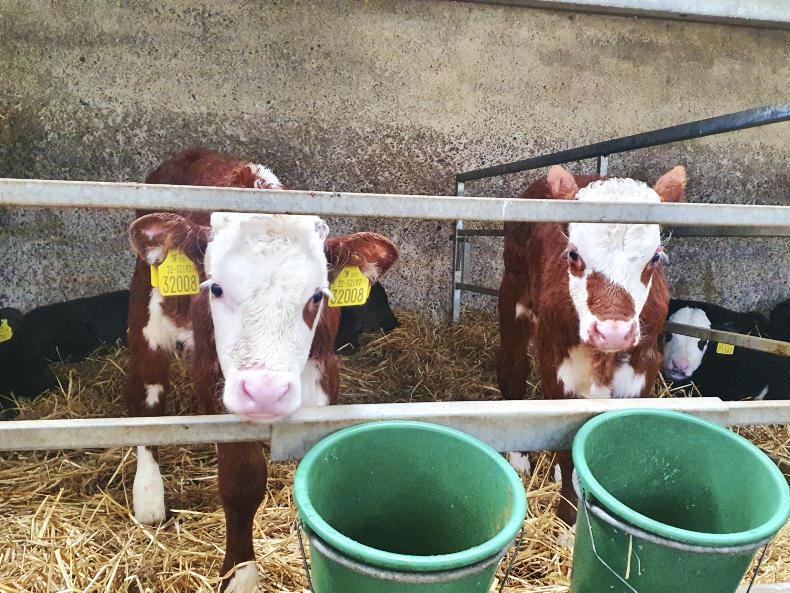
The calf-rearing shed on the demo farm.
Grassland management: this topic could appear both in ‘the good’ and ‘the room to improve’ category.
While grazing quality throughout the year was excellent, managing grass on a dairy calf to beef enterprise is quite difficult.
Grass supply in the first half of the grazing season outstrips demand quite significantly.
This means there is a need to make quite a large amount of silage from surplus grazing.
While this is a help in securing enough winter fodder, there comes a point when there are too many bales of silage in the yard.
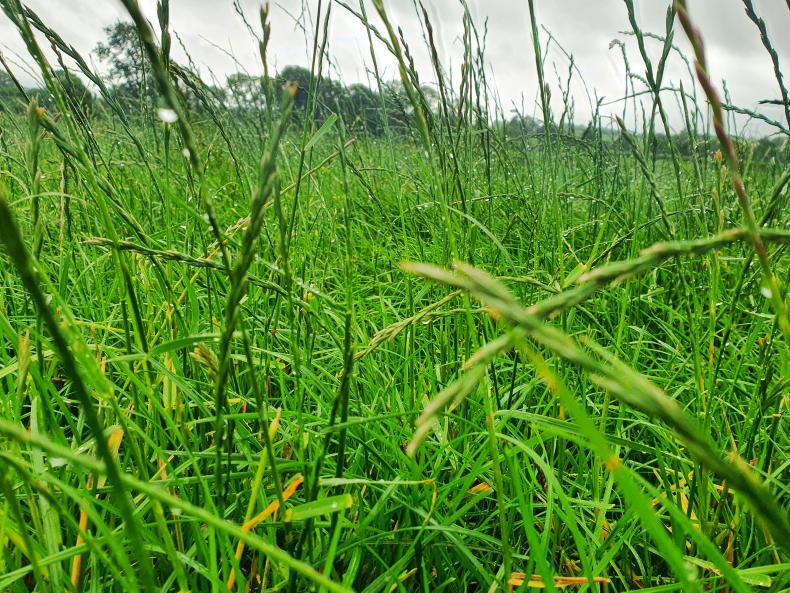
Surplus grazing in the early part of the grazing season can be an issue on an all dairy-beef enterprise farm.
This year on the demo farm, we are looking at over 200 bales of silage in excess of requirement – this is not something you would want to be doing every year.
Selling this high-quality silage rarely pays enough to cover the input costs in making it - especially in a year like this when fodder seems to be in good supply.
There may be an option to bring in extra cattle for the first half of the grazing season in order to utilise the grass.
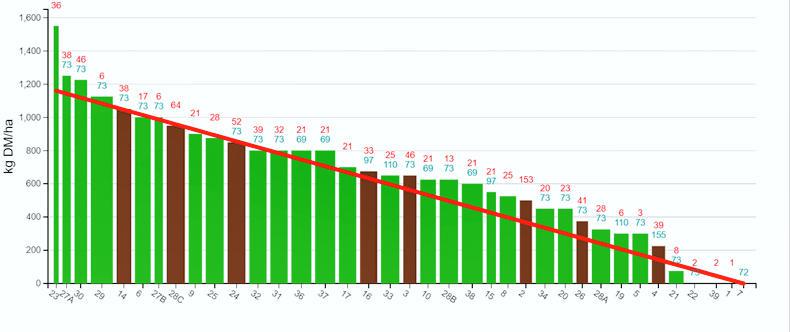
Grass wedge from the demo farm in late summer.
Consistently hitting pre-grazing yields of between 1,200kg DM/ha and 1,400kg DM/ha for the calves really paid off in terms of liveweight gain this year.
This was only possible through regular measuring of grass.
This gave us the information and confidence to skip paddocks that had gone too strong and move to the next paddock that was just perfect for grazing for the calves.
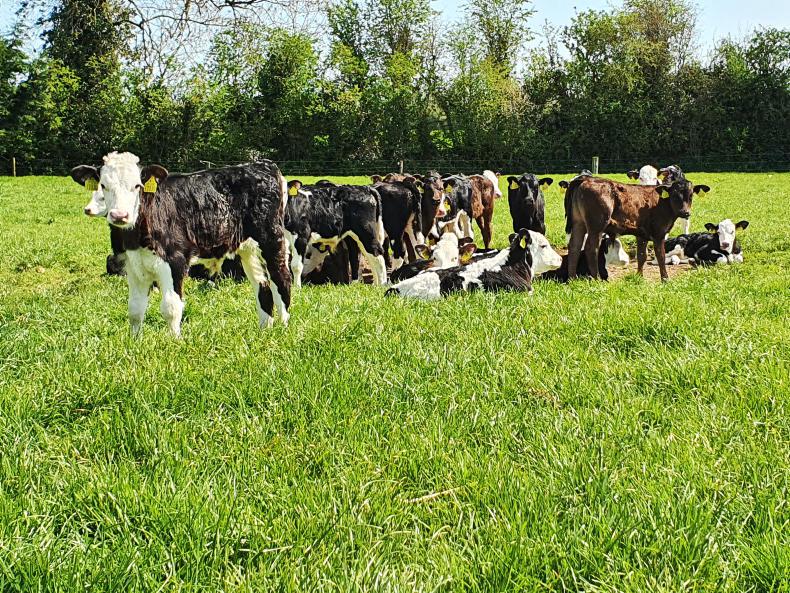
Calves grazing in mid-summer.
Castration: next year I would like to castrate the male calves at an earlier stage.
This year, it was early September when they were castrated.
Moving this back to late June or early July would see it done in better weather conditions, while also having a younger calf that will have less of a check in growth post-castration.
Drafting for slaughter: another area where there is room for improvement is getting the drafting date right on more animals.
While the numbers were small, there were still a number of cattle that were not hitting the spec for fat score.
With heifers, this tended to be over-fat, while a couple of continental bullocks were at the other end of the spectrum – especially just after housing when animals seemed to go backwards for a two- to three-week period.
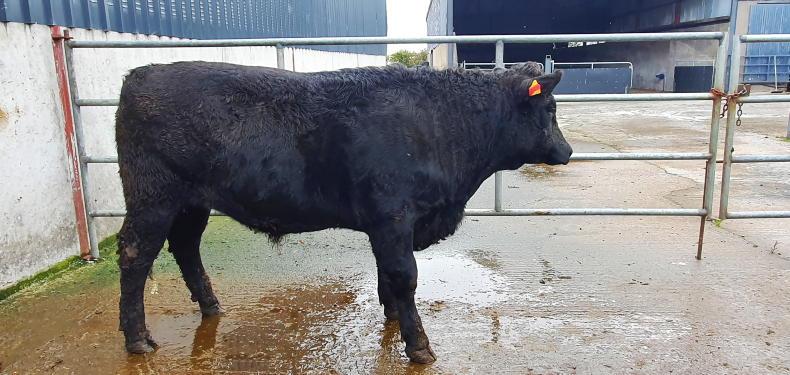
This Limousin bullock graded R- 3+ with a 330kg carcase weight making €1,252.
With these type of cattle, a week can make a huge difference either way in terms of fat score.
Regular drafting is essential to try to avoid going out of spec.
For example, a heifer that you feel is not fit enough for slaughter this week could be over-fat in three weeks’ time if that is the next time you are drafting cattle.
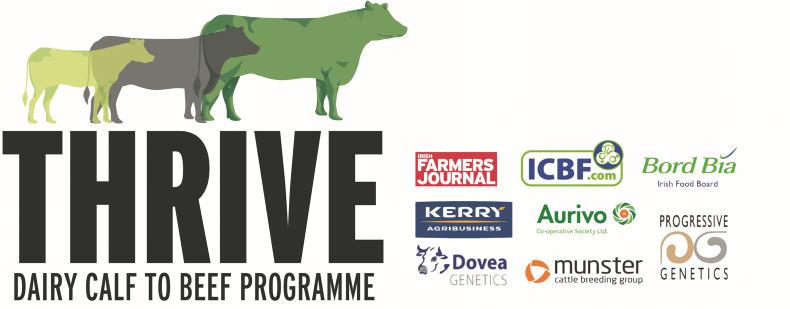
Thrive dairy calf to beef programme logo
Looking back on 2020, there have been both highs and lows on the Thrive demo farm.
It is important for all farmers, no matter what their system of production, to take time to reflect on the year that has passed and identify key areas where things went right and wrong.
Often, we can focus only on what went wrong, but identifying areas that were well done are equally important so that you can maintain standards for the year ahead.
Calf price: buying 140 calves in a short period of time can be quite a task. It is important to have a calf specification in mind and a budget and stick to them.
Last spring, we stuck to budget quite closely, meaning we had an average heifer price of €171 and an average bull calf price of €204 at about three weeks of age.
As we are comparing calves sired by multiple breeds, this ranged from €155 for Angus heifers to €310 for Belgian Blue bull calves.
On average, calf price was back €19/head on 2019 prices.
We must remember that we are buying from the farmer’s yard, calves of known AI sires and, as a result, the calf price reflects this.
Calf rearing: farmer John Hally did a superb job once again last spring in terms of calf rearing.
A good start to life is critical in dairy-beef systems and attention to detail in the rearing shed is the only way to achieve this.
From calf comfort in terms of bedding, airflow and ventilation, calf nutrition and animal health, every minute detail is carefully thought of and managed on the farm.

The calf-rearing shed on the demo farm.
Grassland management: this topic could appear both in ‘the good’ and ‘the room to improve’ category.
While grazing quality throughout the year was excellent, managing grass on a dairy calf to beef enterprise is quite difficult.
Grass supply in the first half of the grazing season outstrips demand quite significantly.
This means there is a need to make quite a large amount of silage from surplus grazing.
While this is a help in securing enough winter fodder, there comes a point when there are too many bales of silage in the yard.

Surplus grazing in the early part of the grazing season can be an issue on an all dairy-beef enterprise farm.
This year on the demo farm, we are looking at over 200 bales of silage in excess of requirement – this is not something you would want to be doing every year.
Selling this high-quality silage rarely pays enough to cover the input costs in making it - especially in a year like this when fodder seems to be in good supply.
There may be an option to bring in extra cattle for the first half of the grazing season in order to utilise the grass.

Grass wedge from the demo farm in late summer.
Consistently hitting pre-grazing yields of between 1,200kg DM/ha and 1,400kg DM/ha for the calves really paid off in terms of liveweight gain this year.
This was only possible through regular measuring of grass.
This gave us the information and confidence to skip paddocks that had gone too strong and move to the next paddock that was just perfect for grazing for the calves.

Calves grazing in mid-summer.
Castration: next year I would like to castrate the male calves at an earlier stage.
This year, it was early September when they were castrated.
Moving this back to late June or early July would see it done in better weather conditions, while also having a younger calf that will have less of a check in growth post-castration.
Drafting for slaughter: another area where there is room for improvement is getting the drafting date right on more animals.
While the numbers were small, there were still a number of cattle that were not hitting the spec for fat score.
With heifers, this tended to be over-fat, while a couple of continental bullocks were at the other end of the spectrum – especially just after housing when animals seemed to go backwards for a two- to three-week period.

This Limousin bullock graded R- 3+ with a 330kg carcase weight making €1,252.
With these type of cattle, a week can make a huge difference either way in terms of fat score.
Regular drafting is essential to try to avoid going out of spec.
For example, a heifer that you feel is not fit enough for slaughter this week could be over-fat in three weeks’ time if that is the next time you are drafting cattle.

Thrive dairy calf to beef programme logo












 This is a subscriber-only article
This is a subscriber-only article












SHARING OPTIONS: